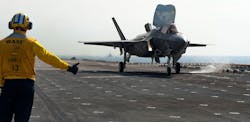Navy taps Raytheon for carrier landing system for Japan that uses differential GPS for aircraft navigation
PATUXENT RIVER NAS, Md. – Aircraft carrier aviation experts at Raytheon Technologies Corp. (RTX) will build one carrier landing system for Japan, which based on differential Global Positioning System (GPS) satellite navigation technology under terms of an $11.9 million order announced last week.
Officials of the Naval Air Systems Command at Patuxent River Naval Air Station, Md., are asking the RTX Raytheon segment in Fullerton, Calif. to one Joint Precision Approach and Landing System (JPALS) unit, one set of onboard repair parts, and one ship GPS sensor assembly V2 for depot spares in support of the country of Japan.
JPALS is an all-weather, all-mission GPS-based landing system that provides landing guidance for fixed-wing aircraft and helicopters aboard aircraft carriers. It features anti-jam protection for operating in electronic warfare (EW) environments.
Related: Raytheon to pursue full-scale development of carrier-based GPS aircraft landing system
This contract includes three production and installation engineering development model unit upgrade kits, engineering change proposals, and data.
JPALS works with the GPS satellite navigation system to provide accurate, reliable, and high-integrity guidance for carrier-based fixed-wing aircraft. It is a differential GPS that will provide an adverse weather precision approach and landing capability.
Differential GPS uses network of fixed-base reference stations to broadcast the difference between the positions indicated by the GPS signals and known fixed positions. A digital correction signal is broadcast locally over short-range fixed-based transmitters.
Related: Honeywell to refurbish and upgrade Navy shipboard precision-approach landing systems
Using differential GPS technology improves satellite navigation and positioning accuracy from about 15 meters using non-enhanced GPS to about 4 inches with differential GPS.
Navy officials say they plan for initial operating capability (IOC) for JPALS sometime this year, and full-operational capability (FOC) as early as 2030. The first JPALS test landings were aboard the aircraft carrier USS Theodore Roosevelt in late 2013. Raytheon won a $232.8 million Navy contract in 2008 for JPALS system development and demonstration.
On this contract Raytheon will do the work in Fullerton, Calif.; and Largo, Fla., and should be finished by March 2025. For more information contact RTX Raytheon online at www.rtx.com/raytheon, or Naval Air Systems Command at www.navair.navy.mil.
About the Author
John Keller
Editor-in-Chief
John Keller is the Editor-in-Chief, Military & Aerospace Electronics Magazine--provides extensive coverage and analysis of enabling electronics and optoelectronic technologies in military, space and commercial aviation applications. John has been a member of the Military & Aerospace Electronics staff since 1989 and chief editor since 1995.
